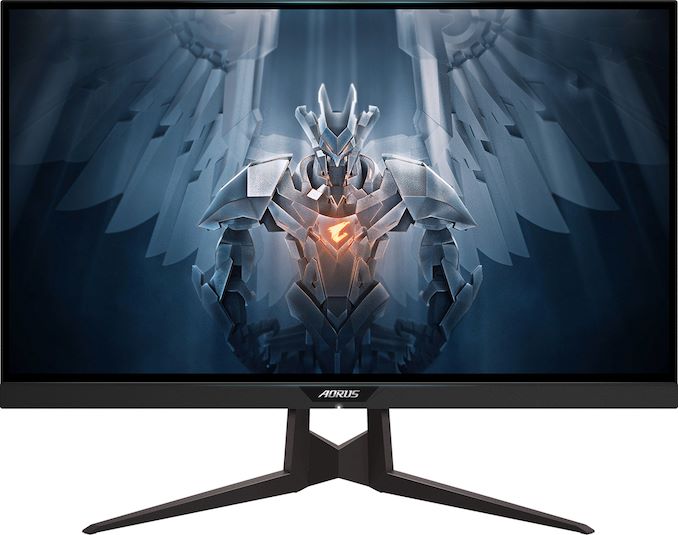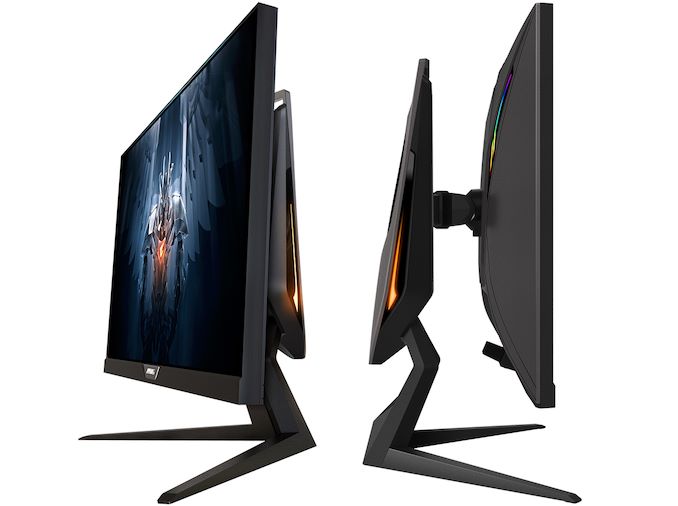More Hz for Less: GIGABYTE Unveils Aorus FI27Q 27-Inch 165 Hz Monitor
by Anton Shilov on January 31, 2020 3:00 PM EST
GIGABYTE has introduced its 2nd Generation 27-inch ‘tactical’ display for gamers, updating the display to offer a maximum refresh rate of 165 Hz. The Aorus FI27Q monitor continues to use a high-quality IPS panel and supports a variety of premium features, including VESA adaptive-sync and noise cancellation. Meanwhile, the new LCD is $50 cheaper than its predecessor from last year. Meanwhile, GIGABYTE also announced the Aorus FI27Q-P monitor that has a DisplayPort 1.4 input and some other feature set improvements.
The GIGABYTE Aorus FI27Q is based on a 2560×1440 resolution 8-bit+FRC IPS panel, which offers 350 nits max luminance, a 1000:1 contrast ratio, 178/178 viewing angles, a 1 ms MPRT response time, and a maximum refresh rate of 165 Hz. As you'd expect from such a high refresh rate monitor, the display supports VESA's adaptive-sync variable refresh technology, and is both AMD FreeSync Premium and NVIDIA G-Sync Compatible certified. The LCD also supports GIGABYTE’s Aim Stabilizer technology that reduces motion blur and promises to make fast-paced scenes look sharper, though it is unclear whether it works with variable refresh rates.
Courtesy to its high-quality panel, the Aorus FI27Q monitor can display 95% of the DCI-P3 color gamut and supports HDR mode (presumably using HDR10 transport, but GIGABYTE has not formally confirmed this). Though don't expect the latter to provide a really good HDR experience, given the mediocre brightness.
Being one of the leading makers of computer components, GIGABYTE offers a wide range of products aimed at virtually all segments of the market. But a notable exception to this has been displays, where the company is focusing on the high-end segment and loading its monitors up with extra features. Among other features on the FI27Q is active noise cancellation (ANC) technology for any headset connected to the display, OSD Sidekick to control display options using a keyboard and a mouse, Dashboard to display hardware-related information on top, custom crosshairs, and game profiles.
As far as connectivity is concerned, the Aorus FI27Q display has a DisplayPort 1.2 input, two HDMI 2.0 ports, and audio connectors. Ergonomics-wise, the monitor comes with a stand designed after a falcon and featuring multiple addressable RGB LEDs that can adjust the display’s height, tilt, and swivel. In addition, the LCD has VESA 100mm×100mm mounting holes.
It is noteworthy that GIGABYTE is also offering the Aorus FI27Q-P monitor with a DisplayPort 1.4, which essentially means that the monitor can support a 10-bit input at the monitor's full resolution and 165 Hz refresh rate. By contrast, the Aorus FI27Q only supports an 8-bit input for this scenario due to DP 1.2 bandwidth limitations. In addition, the -P version also comes with ANC 2.0 and Black Equalizer 2.0.
| The GIGABYTE Aorus FI27Q Monitors | |||
| Aorus FI27Q | Aorus FI27Q-P | ||
| Panel | 27" 8-bit + FRC IPS | ||
| Native Resolution | 2560 × 1440 (16:9) |
||
| Refresh Rate | 165 Hz | ||
| Dynamic Refresh Rate | Technology | VESA Adaptive-Sync (AMD FreeSync Premium & NVIDIA G-Sync Compatible Certified) |
|
| Range | 48 - 165Hz | ||
| Response Time | 1 ms MPRT | ||
| Brightness | 350 cd/m² | ||
| Contrast | 1000:1 | ||
| Color Gamut | 95% DCI-P3 | ||
| Viewing Angles | 178°/178° horizontal/vertical | ||
| Curvature | - | ||
| Inputs | 1 × DisplayPort 1.2 2 × HDMI 2.0 |
1 × DisplayPort 1.4 2 × HDMI 2.0 |
|
| USB Hub | - | ||
| Audio | audio connectors | ||
| Proprietary Enhancements | Active Noise Cancellation Aim Stabilizer Black Stabilizer Game Assist custom crosshairs Aorus Dashboard OSD Sidekick Game Profiles |
Active Noise Cancellation 2.0 Aim Stabilizer Black Stabilizer 2.0 Game Assist custom crosshairs Aorus Dashboard OSD Sidekick Game Profiles |
|
| Stand | Height | 130 mm | |
| Tilt | +21° ~ -5° | ||
| Swivel | +20° ~ -20° | ||
| Power Consumption | Idle | 0.5 W | |
| Typical | ? | ||
| Maximum | 75 W | ||
| MSRP | $549 | ? | |
The GIGABYTE Aorus FI27Q (and perhaps FI27Q-P) display is now available from retailers like Amazon and Newegg for $549, which is $50 lower compared to the launch price of the Aorus AD27QD.
Related Reading:
- GIGABYTE’s Aorus CV27Q Curved ‘Tactical’ Monitor: 165 Hz QHD With FreeSync 2
- CES 2019: A Monitor from GIGABYTE? The 1440p 144 Hz IPS FreeSync 'Aorus AD27QD'
- AOC Launches CQ27G1 Curved Monitor: 27 Inch, 144 Hz, FreeSync, Sub-$300
- Samsung’s CRG5 Curved 27-Inch 240 Hz G-Sync Monitor Now Available for $370
- Dell Rolls Out 32-Inch QHD Curved Gaming Monitor (S3220DGF): Up To 165Hz with FreeSync 2
- LG Unveils 27 and 37.5-Inch IPS Monitors with 1 ms Response Time
Source: GIGABYTE












25 Comments
View All Comments
TristanSDX - Friday, January 31, 2020 - link
less than 240 Hz is now slow and obsoletecrimsonson - Friday, January 31, 2020 - link
Depends. Is 240 that useful over 165?I say HDR is more important. I rather play 120 and HDR than 240 and SDR.
p1esk - Friday, January 31, 2020 - link
Hz and HDR are orthogonal. You want both. To eliminate motion blur you want at least 1000Hz (see journey to 1000Hz by Michael Abrash). I'm typing this on 144Hz monitor, and it's definitely not enough.JoeyJoJo123 - Saturday, February 1, 2020 - link
Don't think you really understand. LCD is inherently a sample-and-hold display technology. This is unlike CRTs or Plasmas of yesteryear, which had markedly better clarity in motion, due to flashing the color between distinct phases of black.What needs to happen, even more so than increasing Hz, is decreasing pixel persistence and increasing backlight strength. You can already use "lightboost" or "ULMB" or "ELMB" types of settings on monitors, but that hardly matters when people don't want to feel like they're playing on a super dim display that now dropped to 80 ~ 100 nit brightness just by enabling a motion blue reduction setting on their display.
What I'm trying to get at is 1000hz will change hardly anything at all, and that's why the move between 120hz to 144 to 165 to 240 to 360 has largely been meaningless for most people's eyes, since the pixel persistence hasn't changed much at all.
Now if you could do 1000hz, where backlight could strobe at 3000hz or so (1 frame on, 2 frames off), yet still retain an average brightness of ~400nits or so (despite the ~33% duty cycle), you'd effectively have eliminated 66% of the pixel persistence, without sacrificing a usable brightness. And such a display would truly be amazing. But we're still pretty far from that kind of reality, and people might even need to accept thicker monitors to achieve that kind of brightness-after-ULMB setting.
p1esk - Saturday, February 1, 2020 - link
I'm not talking about existing LCDs. By the time 4k @ 1000Hz becomes feasible (5-10 years from now), all new monitors will be MicroLED based.Beaver M. - Sunday, February 2, 2020 - link
5 to 10 years?You mean like flying cars in 2020?
willis936 - Sunday, February 2, 2020 - link
This seems a little misguide, but it’s close. What matters isn’t the existence of strobing. Nature has “perfect motion clarity” and it does not strobe. What matters is the length of the hold time. ULMB decreases this, but so do higher refresh rates. CRT phosphors had decay times into the multiple ms. At 1000 Hz, with a fast switching technology like OLED, the benefit of strobing would be smaller, arguably negligible.crimsonson - Saturday, February 1, 2020 - link
There is nothing wrong with motion blur. We perceive them naturally in the real (analog) world. As JJJ123 explained, sample and hold display has inherent characteristics that renders blur differently than other mediums. And why I think 240 is really not that important over 120-165.Not to mention the ability of modern GPUs to achieve FPS above 120 FPS unless with significant render settings. So while you may achieve 120+ you sacrifice something else.
Yes future should get better but future games will also add new things like bigger textures, ray tracing, more triangles. It’s a moving target.
And at the end of the day, it’s about immersion. Refresh rate is just one factor. Let’s not compromise everything else for it especially when going from 165 to 240 can be relatively minor.
mode_13h - Saturday, February 1, 2020 - link
If you play games by holding your eyes fixed at one point on the monitor, then you might be right that motion blur doesn't matter (for you).However, for those of us who want to clearly see objects as they move around on the screen, then motion blur sucks. Objects which your eyes are tracking should *not* be blurred, because the relative motion between them and your eye is (nominally) zero. That's the true benefit of HFR displays.
p1esk - Saturday, February 1, 2020 - link
> Objects which your eyes are tracking should *not* be blurredExactly. Reading text while scrolling on a 60Hz monitor after using 144Hz one feels like scratching your eyeballs with sand paper.
I haven't had a chance of trying 240Hz monitor yet, but I expect noticeable improvements, because 144Hz is still way too blurry for me.